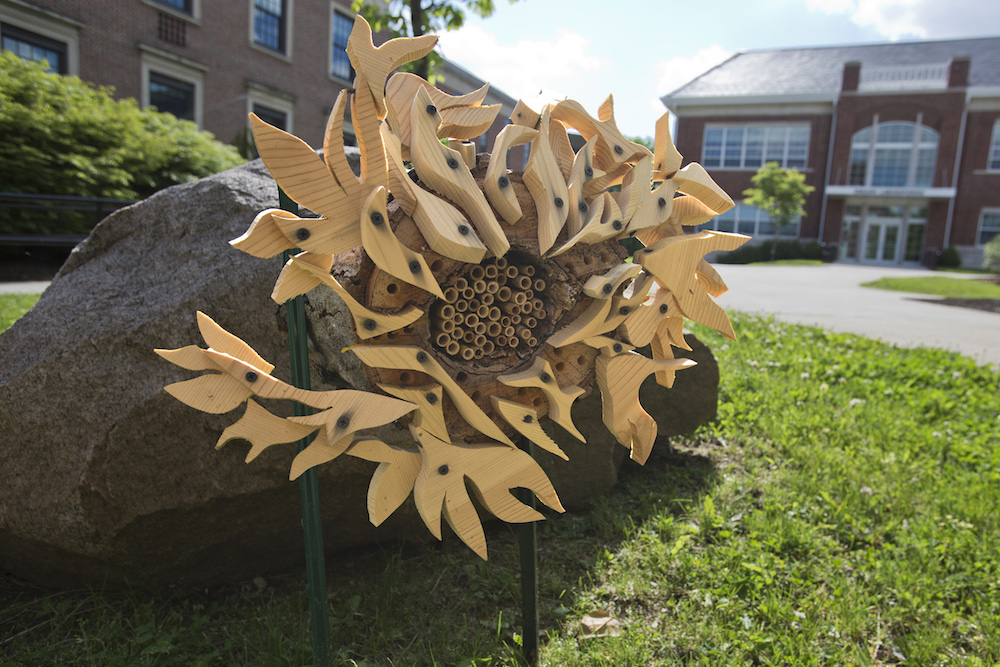A conversation between Biology Professor Andy McCall and Professor Micaela Vivero from Studio Art sparked the idea of connecting McCall’s biology class with a sculpture class through the study of mason bees, a species known for making “masonry” compartments of mud in their nests to house each individual egg they lay.
“These bees are great native pollinators,” according to McCall, and with the worrisome decline in honeybee populations, there’s some hope that mason bees could help supplement certain gaps in critical honeybee pollination, particularly with wildflowers. “Mason bees are very gentle,” McCall adds, “and will only sting if you touch or corner them.”
Vivero’s mixed-media sculpture class designed and created fifteen unique structures made of natural materials, using practical information from McCall and a local beekeeper, as well as a great deal of inspiration from Italo Calvino’s imaginative 1972 novel, “Invisible Cities.”
“Students have been exposed to working in collaboration with other disciplines, and artists many times need to collaborate with experts in other fields to complete projects that are meaningful and useful.” - Micaela Vivero, Studio Art
The primary function of these “bee hotels” was to attract mason bees with the features they need for nesting. The dwellings were distributed in mid-spring to a variety of locations across campus in the hope that the bees would begin to inhabit them through the summer, so that by fall semester of 2016, McCall’s plant reproductive class would be able to start collecting and analyzing data.
The biology students will examine them for invertebrate life and identify all organisms by order and family. They’ll analyze the data using standard statistical techniques to see if insect abundance or composition depends on the placement or specific characteristics of the bee hotels.
“This project presented a lot of challenges, said Arin Caveney ’19, a theatre major from Lansing, N.Y. “It had to be almost completely made out of wood, which was a material that I had never worked in before. However, these challenges made it really engaging and my favorite project of the class.”
Caveney’s design is based on the fictional city of Zobeide from Calvino’s “Invisible Cities,” a place where generations of men dream of a woman running naked through a winding city. The men build a city to recreate the dream and find the woman, but their efforts are unsuccessful.
“There are multiple parts within my sculpture that reference this story. The outside of the bee hotel has a hexagonal shape, while the inside has bunches of cylindrical pieces of wood, in varying sizes and types. This repetition of circles inside a greater space creates a feeling of being trapped in a limited world, much like the men of Zobeide,” said Caveney.
“My bee hotel is inspired by the fictional city, Chloe, from Calvino’s book,” said Alex Wojenski ’18, a studio art and education double major from St. Keene, N.H. “I divided my project into distinct sections that don’t overlap, because the people in Chloe who ‘move through the streets are always strangers. At each encounter, they imagine a thousand things about one another… but never speak.’”
Even without knowing each story, the individual designs reflect an integration of imagination with function, and also a thoughtful sense of the environment in which the shapes and materials have been installed.
“With this collaboration, students have become aware of some of the important and lasting impacts that art can have on the world around us,” Vivero observes. “Also, students have been exposed to working in collaboration with other disciplines, and artists many times need to collaborate with experts in other fields to complete projects that are meaningful and useful.”
Bees have been buying into the new real estate through the summer, with evidence of grass and mud packing the nest entrances. Mason bees are well-adapted to hibernating in their nests through the cold winter, and when they emerge in the spring, they won’t have to look far for their next address.
Denison’s Center for Learning and Teaching sponsored the bee hotel collaboration as part of its Pedagogical Practice Project. The goal of these projects is to encourage and support faculty who develop specific pedagogical innovations, well beyond normal course revisions, to infuse into a particular course. The Center provides support, resources, mentoring and professional development programs for faculty at all career stages related to their practice of effective teaching skills.
“This project demonstrates the impact of a well-designed collaborative teaching partnership that will help students to develop meaningful interdisciplinary connections between art and science,” said Frank Hassebrock, director of the Center for Learning and Teaching.






